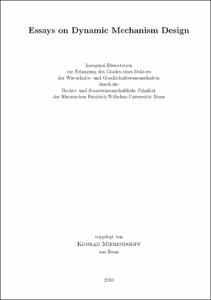Essays on Dynamic Mechanism Design

Essays on Dynamic Mechanism Design

| dc.contributor.advisor | Moldovanu, Benny | |
| dc.contributor.author | Mierendorff, Konrad | |
| dc.date.accessioned | 2020-04-14T12:15:28Z | |
| dc.date.available | 2020-04-14T12:15:28Z | |
| dc.date.issued | 07.07.2010 | |
| dc.identifier.uri | https://hdl.handle.net/20.500.11811/4275 | |
| dc.description.abstract | We consider the allocation of one or several units of a good in a dynamic environment. The time horizon is finite and in each period, a random number of potential buyers arrives. In Chapter 1, we study revenue maximization in an environment where buyers are privately informed about their valuations and their deadlines. Depending on the type distribution, the incentive compatibility constraint for the deadline may or may not be binding in the optimal mechanism. We identify a static and a dynamic pricing effect that drive incentive compatibility and violations thereof. Both effects are related to distinct properties of the type distribution and sufficient conditions are given under which each effect leads to a binding or slack incentive constraint for the deadline. An optimal mechanism for the binding case is derived for the special case of one object, two periods and two buyers. It can be implemented by a fixed price in period one and an asymmetric auction in period two. In order to prevent buyer one from buying in the first period when his deadline is two, the seller sets a reserve price that is lower than in the classic (Myerson, 1981) optimal auction and gives him a (non-linear) bonus. The bonus leads to robust bunching at the top of the type-space. Chapter 2 contains a characterization of asymmetric reduced form auctions. In chapter 3, we consider a more general dynamic environment in which buyers' valuations may depend on the time of allocation in an arbitrary way. We show that the static Vickrey auction can be generalized to the dynamic framework. This yields a simple payment rule for the implementation of the efficient allocation rule of a single object. To define the dynamic Vickrey auction, we show that the multi-dimensional type-space can be reduced to essentially one dimension. This allows to define the winner's payment as the lowest valuation in the reduced type-space, that suffices to win. Finally we define an ascending clock-auction with an equilibrium-outcome that coincides with the outcome of the dynamic Vickrey auction. | en |
| dc.language.iso | eng | |
| dc.rights | In Copyright | |
| dc.rights.uri | http://rightsstatements.org/vocab/InC/1.0/ | |
| dc.subject.ddc | 330 Wirtschaft | |
| dc.title | Essays on Dynamic Mechanism Design | |
| dc.type | Dissertation oder Habilitation | |
| dc.publisher.name | Universitäts- und Landesbibliothek Bonn | |
| dc.publisher.location | Bonn | |
| dc.rights.accessRights | openAccess | |
| dc.identifier.urn | https://nbn-resolving.org/urn:nbn:de:hbz:5-21833 | |
| ulbbn.pubtype | Erstveröffentlichung | |
| ulbbnediss.affiliation.name | Rheinische Friedrich-Wilhelms-Universität Bonn | |
| ulbbnediss.affiliation.location | Bonn | |
| ulbbnediss.thesis.level | Dissertation | |
| ulbbnediss.dissID | 2183 | |
| ulbbnediss.date.accepted | 25.06.2010 | |
| ulbbnediss.fakultaet | Rechts- und Staatswissenschaftliche Fakultät | |
| dc.contributor.coReferee | Jehiel, Philippe |
Files in this item
This item appears in the following Collection(s)
-
E-Dissertationen (285)




